Gomashio Sesame Salt Recipe
Great on Grains and Veggies
This Gomashio Sesame Salt Recipe is easy to make, and one you will want to have around, especially when following a macrobiotic / whole plant foods diet. It is among the must-have condiments for macrobiotic cooking, providing a salty flavor with less total salt.
Gomashio Sesame Salt is the perfect condiment to sprinkle on top of brown rice and other whole grains ~ including your morning porridge ~ along with greens and vegetables.
In this article, I share why we (and many others) love Gomashio, how to make this simple recipe ~ including what type of suribachi to buy ~ and ways to vary the ratio of seeds to salt, and the type of seeds or even nuts you can use.
Although you can purchase Gomashio ready made, (I recommend Eden brand Gomashio), there's no comparison to home made! Give this Gomashio Sesame Salt Recipe a try! Once you make your first batch, and try it on top of brown rice or other whole grains, you'll be hooked!
- Home
- Meal Prep / Batch Cooking Tips
- Best Brown Rice, Rice Balls, Sushi & Porridge
- Condiments for Macrobiotic Cooking
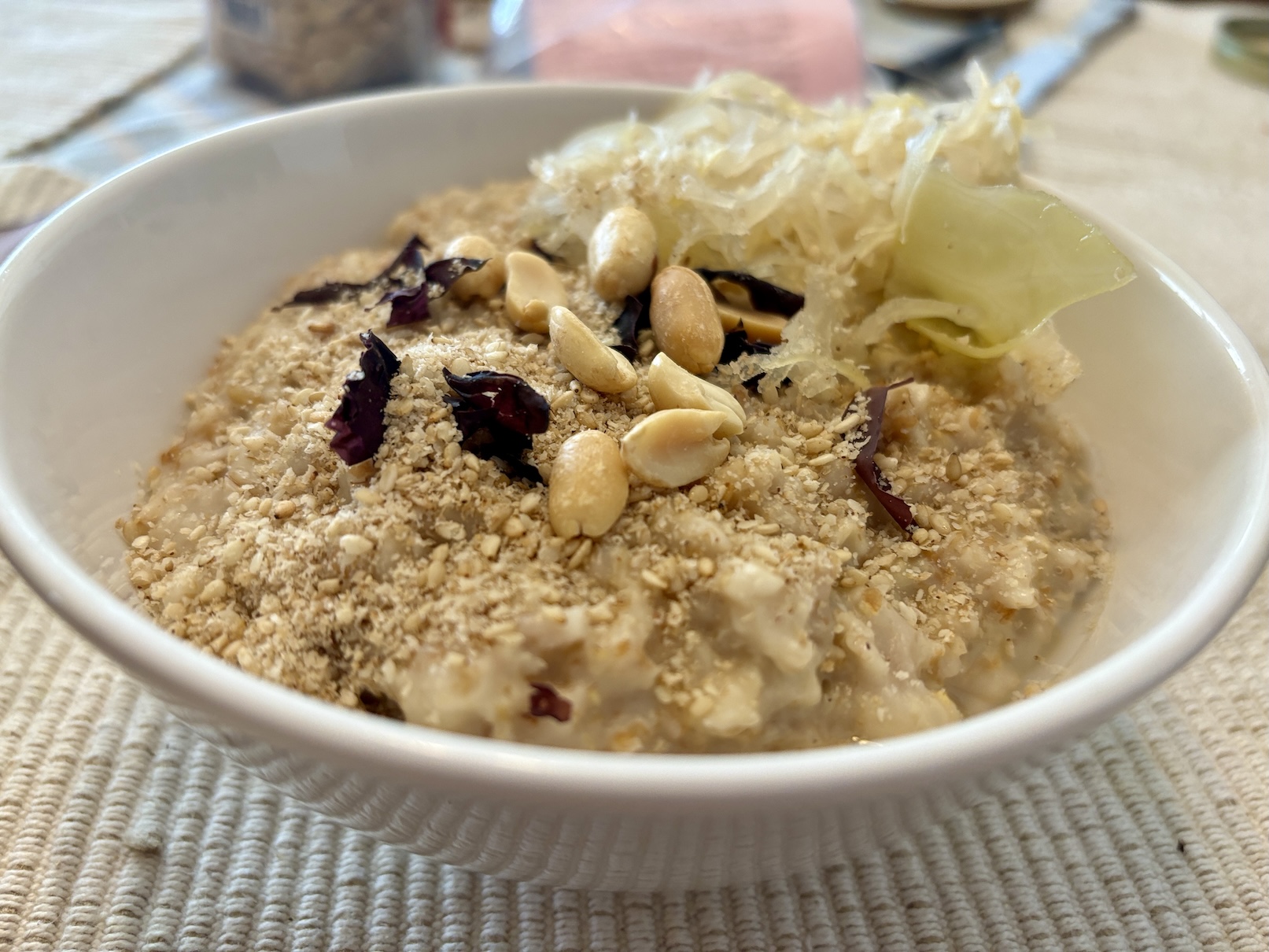 BF Oats (& optional barley, millet, or LO brown rice) is great topped with Gomashio, dulse, chopped dry roasted peanuts & sauerkraut
BF Oats (& optional barley, millet, or LO brown rice) is great topped with Gomashio, dulse, chopped dry roasted peanuts & sauerkraut"It is in the preparation of simple foods like rice and gomashio that a cook's real skill is tried. It is far easier to assemble a rich gourmet feast than to produce consistently delicious, well-balanced sesame-salt. Mastery of this simple condiment means mastery of the center of your life." ~ The Art of Just Cooking, Lima Ohsawa
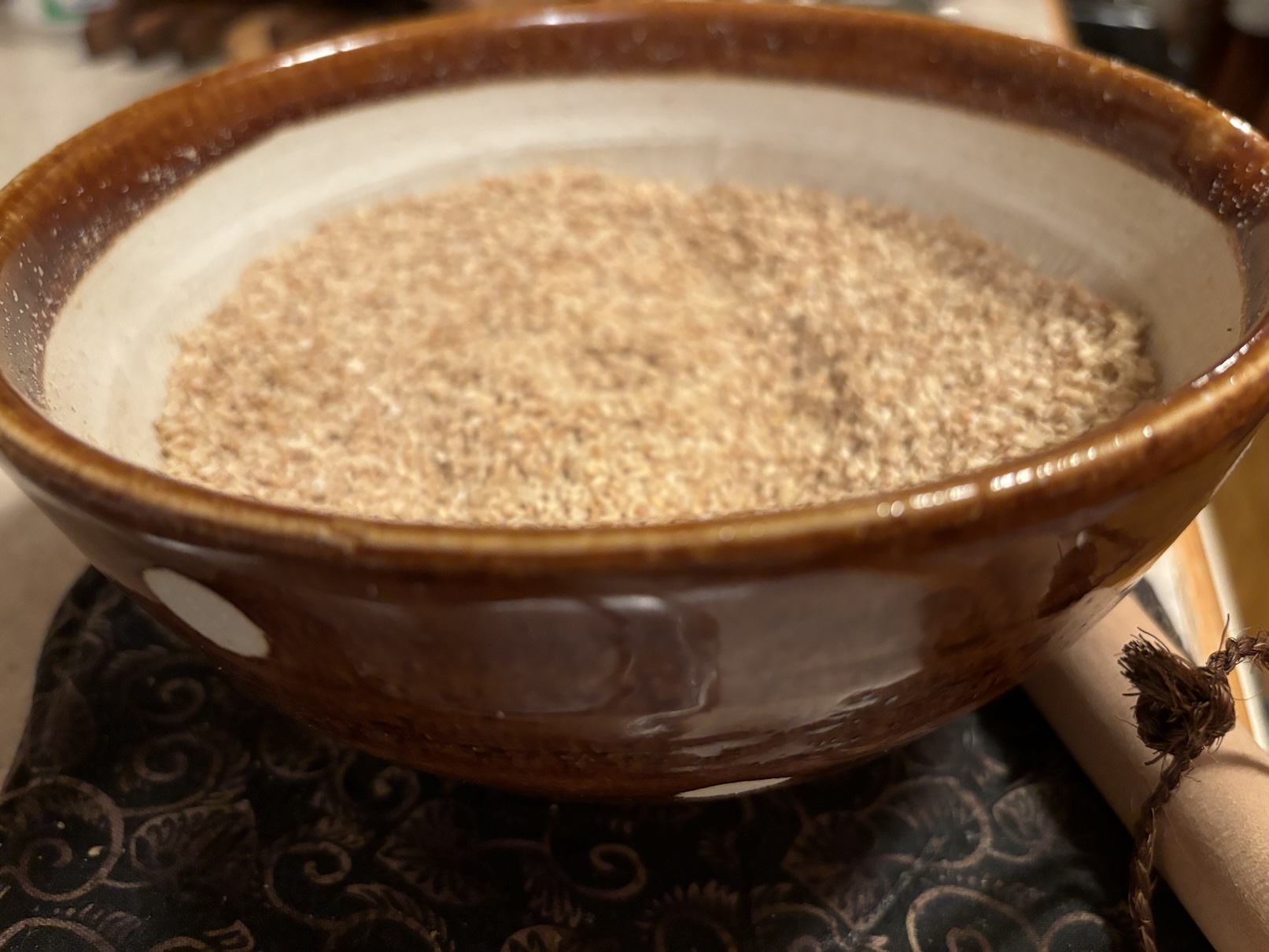 Grinding Roasted Sesame Salt (Gomasio) in the suribachi
Grinding Roasted Sesame Salt (Gomasio) in the suribachi
Why We Love Gomashio Sesame Salt
As I wrote in my article about Condiments for Macrobiotic Cooking, the right condiments help the natural flavors of fresh, natural plant foods come alive.
Seasonings and condiments for macrobiotic cooking are adjusted seasonally and as needed individually, depending on one's condition, all of which contribute to the overall enjoyment and balance of a meal, and its effectiveness at improving health.
Salt is important for digestion, however, adding salt directly on top of cooked foods can taste harsh, or lead to excessive thirst and fluid consumption which taxes the kidneys.
As Cornelia Aihara (1926-2006) states in her book, The Do of Cooking, Complete Macrobiotic Cooking for the Seasons, "Sesame seeds have a very high quality oil and a good ratio of calcium and phosphorous which aid development of the nervous system and bone formation. The lecithin in sesame seeds dissolves cholesterol which accumulates on the walls of the veins and arteries, helping to eliminate the possibility of heart attack or high blood pressure."
Roasting sesame seeds brings out their natural oils which coat the salt granules, making it more palatable, enhancing the flavor of whole grains and vegetables with less overall salt, while improving digestibility of the whole grains.
Try making this Gomashio Sesame Salt Recipe, and add a teaspoon or so to your morning porridge, brown rice, noodle dishes, greens and/or vegetables. I'm sure once you do, you'll want to keep this in your weekly meal prep rotation.
Just an FYI, I also have a Gomashio Sesame Salt Recipe in The Macrobiotic Action Plan, Your MAP to Greater Health & Happiness, and Basic Macrobiotic Menus & Recipes (to be republished, 2025) which I'm reprinting below.
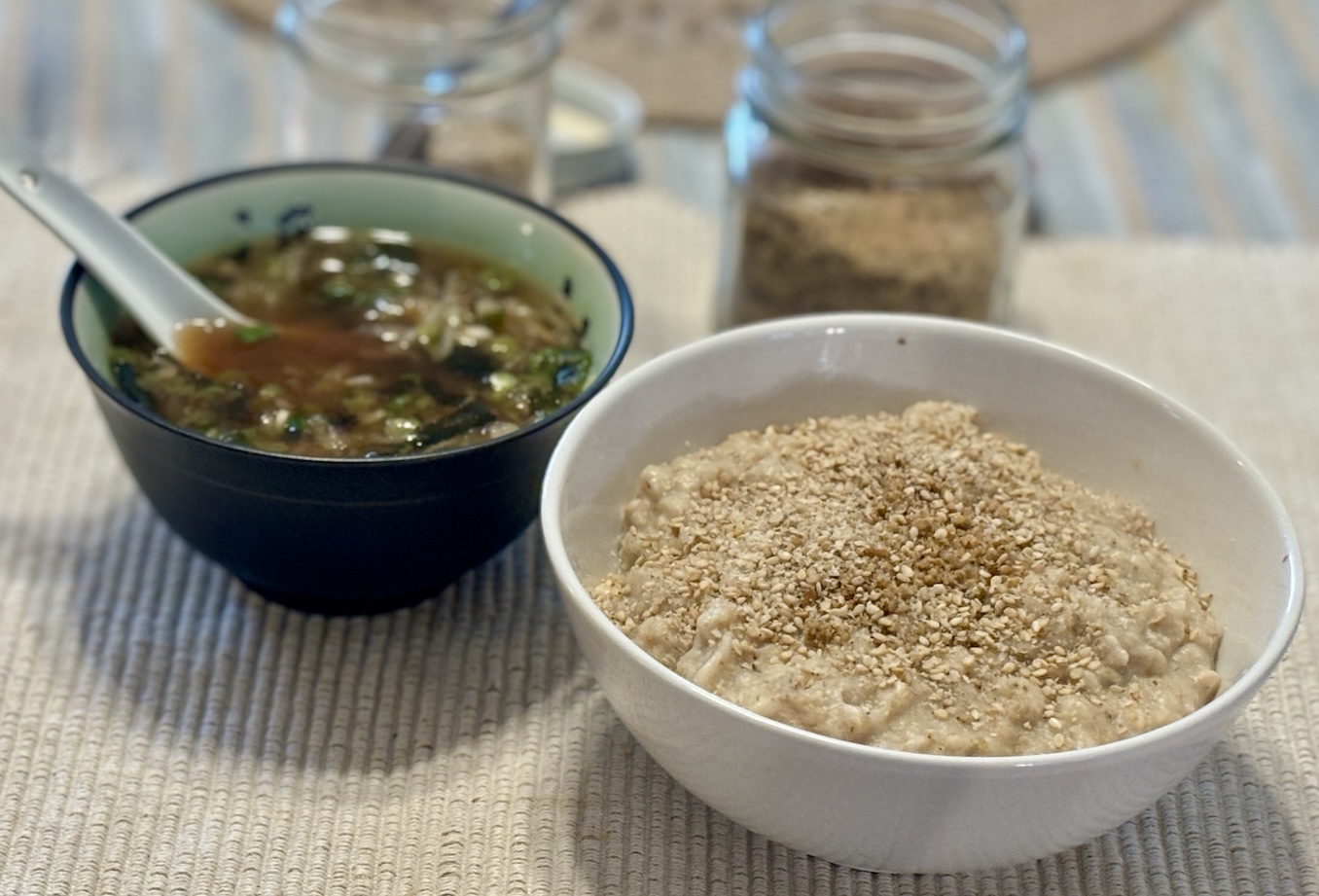 Oat Barley Porridge Miso Soup with jars of Black Walnut-Salt & Gomashio Sesame Salt in the background - Macrobiotic Breakfast Oat Barley Porridge Miso Soup with jars of Black Walnut-Salt & Gomashio Sesame Salt in the background - Macrobiotic Breakfast |
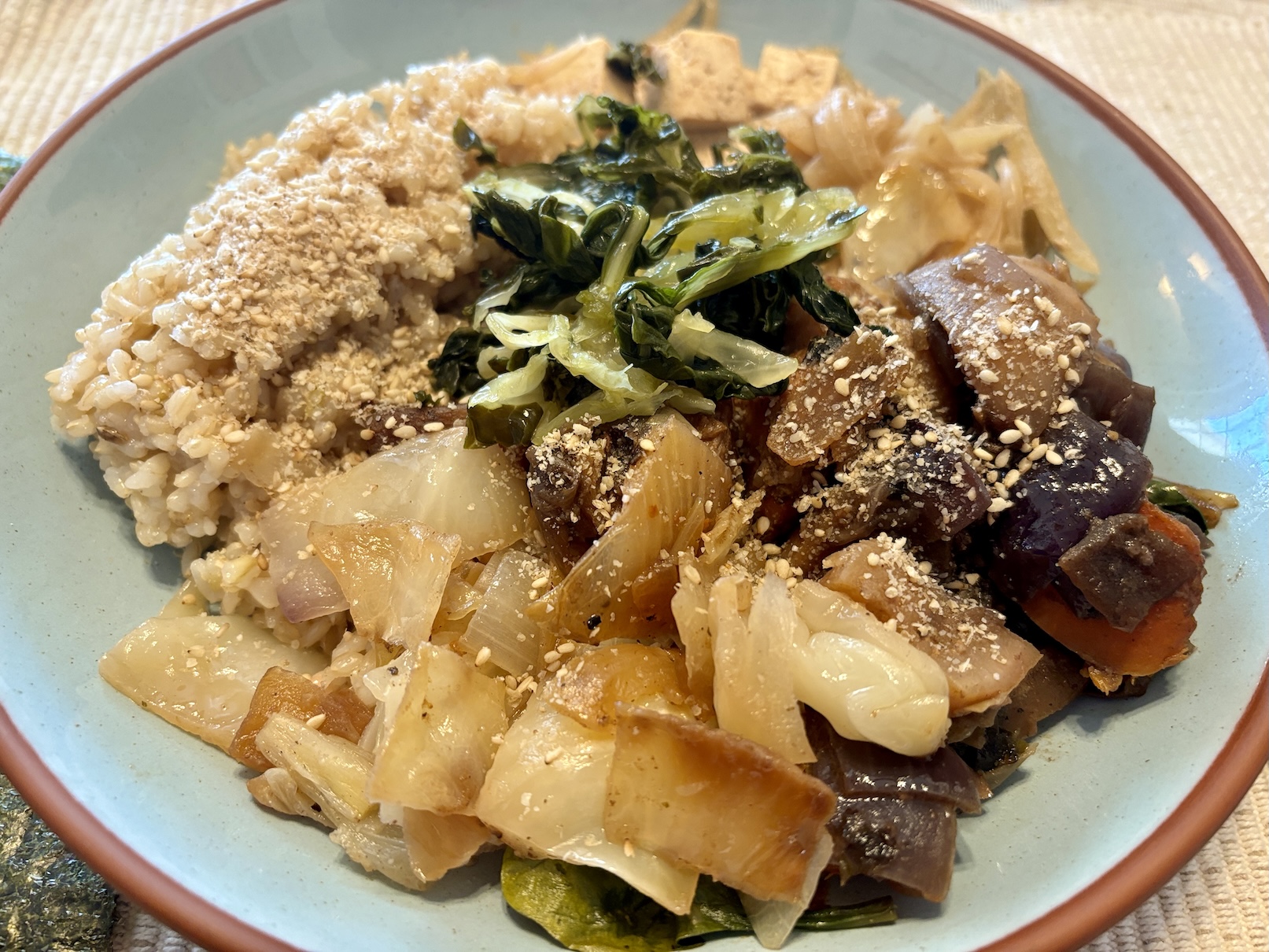 Medium-Grain Brown Rice + Sweet Brown Rice Blend with Nishime - Japanese style Vegetables, a good dish for the fall / winter diet Medium-Grain Brown Rice + Sweet Brown Rice Blend with Nishime - Japanese style Vegetables, a good dish for the fall / winter diet |
How to Make Gomashio Sesame Salt Recipe
To start with, you'll want to have a good suribachi. It's a small investment, running anywhere from around $18-35 on average, and as high as $99+ for bigger ones. Once you are in the habit of using one, you'll love having it around for grinding seeds, nuts, spices, and other foods.
Be sure to purchase one that is at least the size of this one, which is 5.91 inches x 5.91 inches and holds 18.6 fluid ounces. (This is still too small for our purposes, but may work for some.) Even better, I recommend getting one like this 7 inch Japanese Ceramic Suribachi, similar in size to ours, pictured above. For a bit more of an investment, a larger 12 inch, (closer in size to our previous suribachi which was lost during our move from Arizona to Michigan) is ideal.
Look for the Japanese style suribachis with a ceramic base, ridges on the inside for grinding, and a wooden pestle. Many of the heavy stone mortar and pestles may look pretty but are heavy and lack the grooved lining needed for adequately grinding seeds.
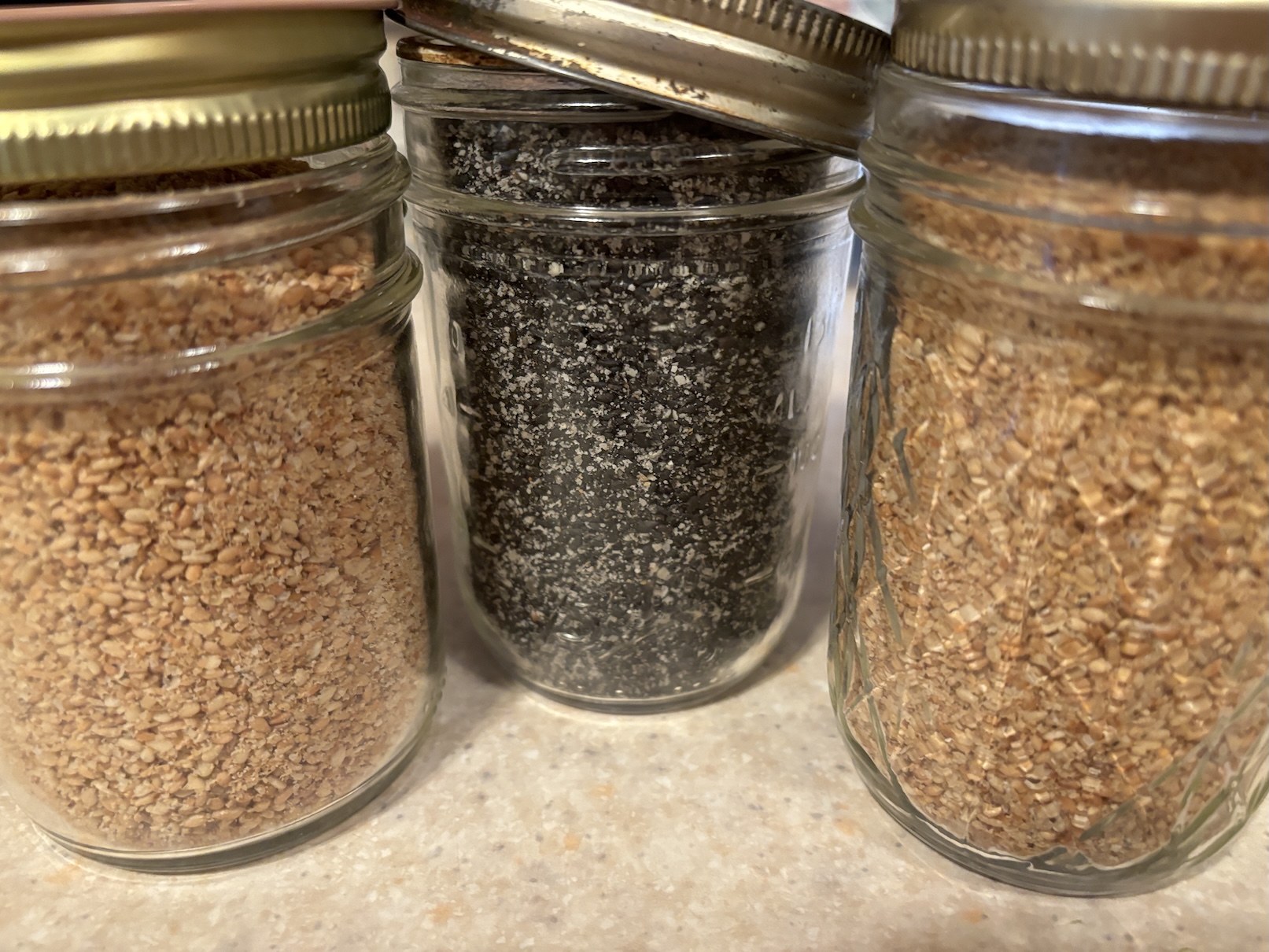 Fresh made Gomashio Sesame Salt - roasted black and brown sesame seeds w/ sea salt
Fresh made Gomashio Sesame Salt - roasted black and brown sesame seeds w/ sea salt"Sesame seeds and salt in combination ... destroy the bad effect of sugar on the whole human organism, and particularly on the nervous and cerebral systems. ...It...penetrates the blood stream and reduces the over-acidity of the blood to normal."
~George Ohsawa, Zen Macrobiotics
Ratio of Sesame Seeds to Salt in the Gomashio Sesame Salt Recipe
We use a blend of 16 parts rinsed and dry roasted sesame seeds to 1 part sea salt, (16 tablespoons, or 1 cup of sesame seeds to 1 tablespoon of sea salt) coarse ground (ideally) in a suribachi. (Mechanical grinding will effect the taste and consistency of the gomashio.)
Aihara's Gomashio Sea Salt recipe called for a 10:1 ratio, or 10 tablespoons of sesame seeds to 1 tablespoon of sea salt. This will taste much saltier by itself, but may be a more ideal ratio once served on top of brown rice, and especially for more potassium-rich vegetables, like my Butternut Squash, Red Onion & Apple Bake, shown below.
The ratio of sesame seeds to sea salt will depend on your taste preferences, and health needs.
In The Art of Just Cooking (the1974 edition with artwork by Nahum Stiskin is now a collectors item, but you can find cheaper copies), Lima Ohsawa uses about 15:1, or 1 cup of sesame seeds to 1 level tablespoon + a dash more sea salt. She states that many, "develop a special affection for gomashio and often overindulge" hence a higher ratio of seeds to salt than older macrobiotic recipes.
In Zen Macrobiotics, 5th Ed., George Ohsawa claims that, "Sesame seeds and salt in combination (four portions of grilled sesame seed powder with one portion of sea salt) destroy the bad effect of sugar on the whole human organism and particularly on the nervous and cerebral systems. Every grain of salt is covered with the oil of crushed sesame seeds and causes no thirst. It meanwhile penetrates the bloodstream and reduces the over-acidity of the blood to normal."
Gomasio can also be made with granulated seaweed, like this Eden Organic Seaweed Gomasio.
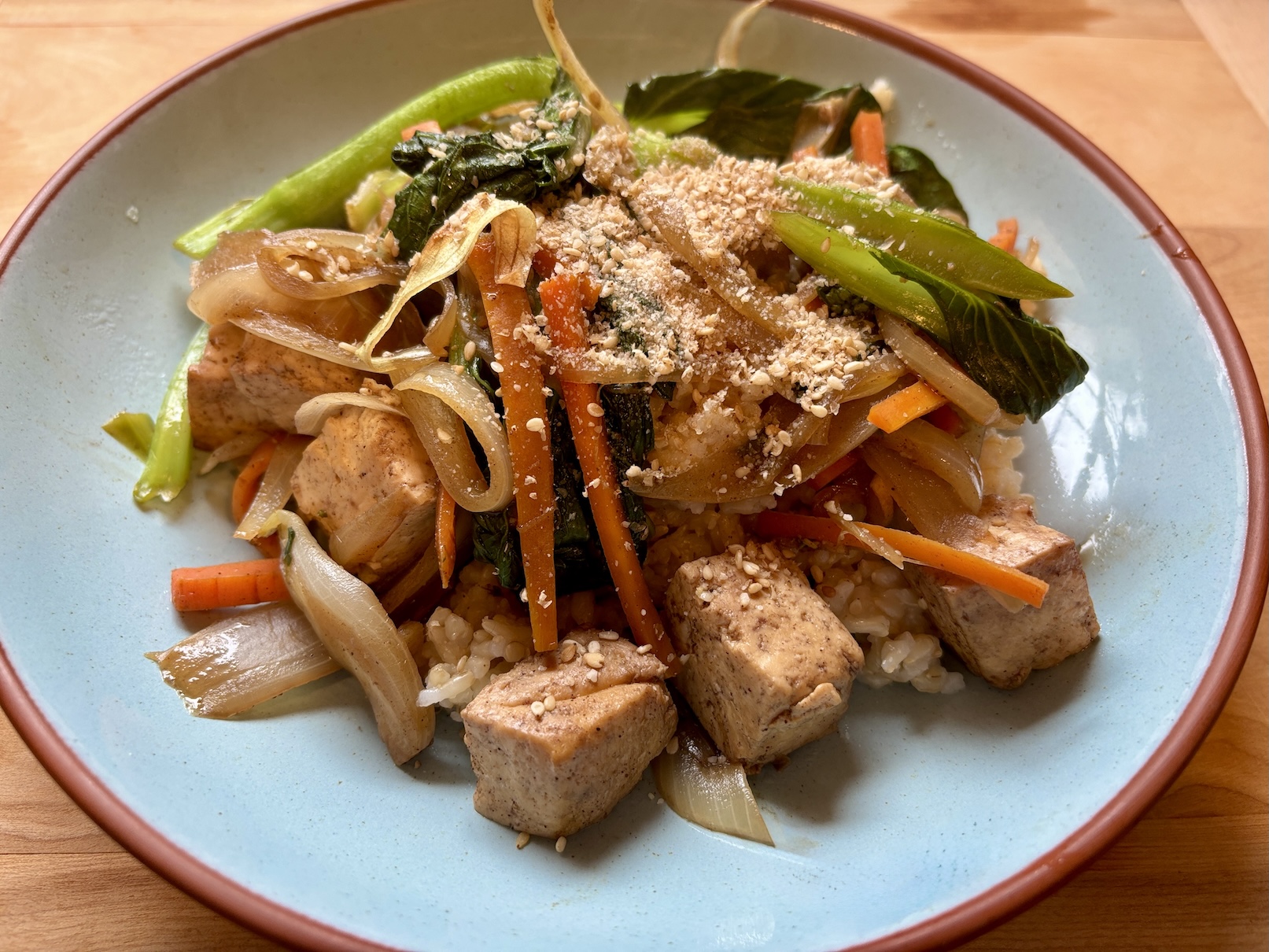 Tofu & Vegeetable Stir Fry garnished with Gomashio
Tofu & Vegeetable Stir Fry garnished with GomashioGomashio Sesame Salt Recipe
Start with a 16:1 Ratio of Sesame Seeds to Sea Salt.
- Rinse 1 cup of brown (or black) sesame seeds in a bowl swishing to remove dirt, then strain in a fine mesh strainer. Let sit to dry for at least half an hour or longer. You can let the seeds sit over night covered loosely with a clean towel.
- Heat a pan on medium. Briefly dry roast 1 Tbsp. sea salt. Stir and roast for a minute or two, until any acrid / chlorine smell is removed. Place in the suribachi and lightly grind.
- Dry roast the sesame seeds. Stir and toss the pan to evenly coat seeds. Brown sesame seeds will turn a little darker brown, and should emit a nice nutty aroma. They are roasted enough when you can easily crush the seeds between your thumb and ring finger.
- Add to suribachi and grind with the pestle, making circular motions until a fair amount of the sesame seed salt is crushed (roughly 70%+/-.) It should have an appealing taste. Over roasting sesame seeds, especially the black ones can make them taste bitter.
- Add a little Gomashio Sesame Salt on top of brown rice, your morning porridge, on vegetables, or as desired. I use anywhere from 1-3 teaspoons per serving, once or twice daily.
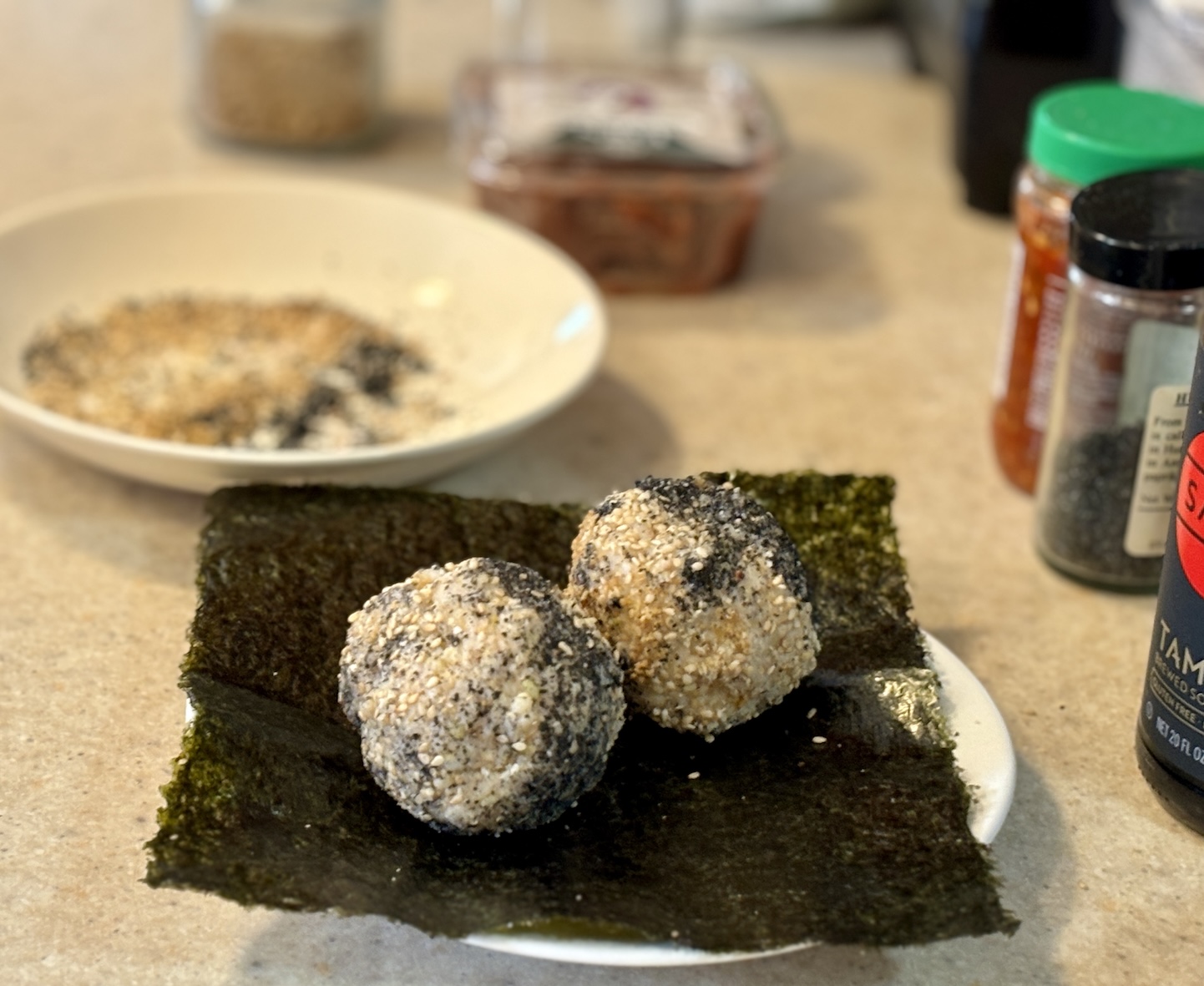 Brown Rice Balls w/ Umeboshi Plum Paste in the Center, Rolled in Gomashio Sesame Salt
Brown Rice Balls w/ Umeboshi Plum Paste in the Center, Rolled in Gomashio Sesame SaltDon and I did the Ohsawa Diet 7 for 7 days, extending with a few extra added vegetables and tofu for another 3+ days. Watch my video series showing what we ate, what we experienced and learned, and my tips for others who may want to try this way of eating for a week or so on my Vegan Great Life YouTube channel.
Look for my Gomsahio Sea Salt Recipe video to come.
Other Nut/Seed Salt Variations to Gomashio
Don made a Walnut-Salt using the same proportions.
Roast 1 cup of walnuts at a low oven temperature of about 250-275º for 10-11 minutes, until they start to turn golden brown, then grind them in the suribachi with 1 tablespoon of briefly roasted sea salt, as in the above recipe. Delicious!
I recently made a Black Walnut-Salt, using black walnuts that were already coarse ground. I used a 10:1 ratio. Black walnuts are used as an herbal treatment for parasites along with wormwood. They definitely tasted a little more bitter, and saltier, yet a great balance on potassium-rich vegetables ~ as shown in the pictures below ~ or our morning Oat Barley Porridge.
I roasted pink Himalayan sea salt first, then the black walnuts, as per the above recipe. As the walnuts were already chopped, the roasting time took about 5-6 minutes.
With walnuts, stop grinding when it looks like the nuts could start to turn into walnut butter or paste.
You can alternatively make a seed-salt using sunflower or pumpkin seeds.
Roasted Butternut Squash, Apple & Red Onion (L) with leftovers re-steamed, and served with Homemade Whole Whet Sourdough Bread with Miso Tahini Spread (bowl on right), Bean Soup (bowl on left) and Black Walnut-Salt in the jar - a perfect salty garnish for the potassium-rich squash & apples!
 |
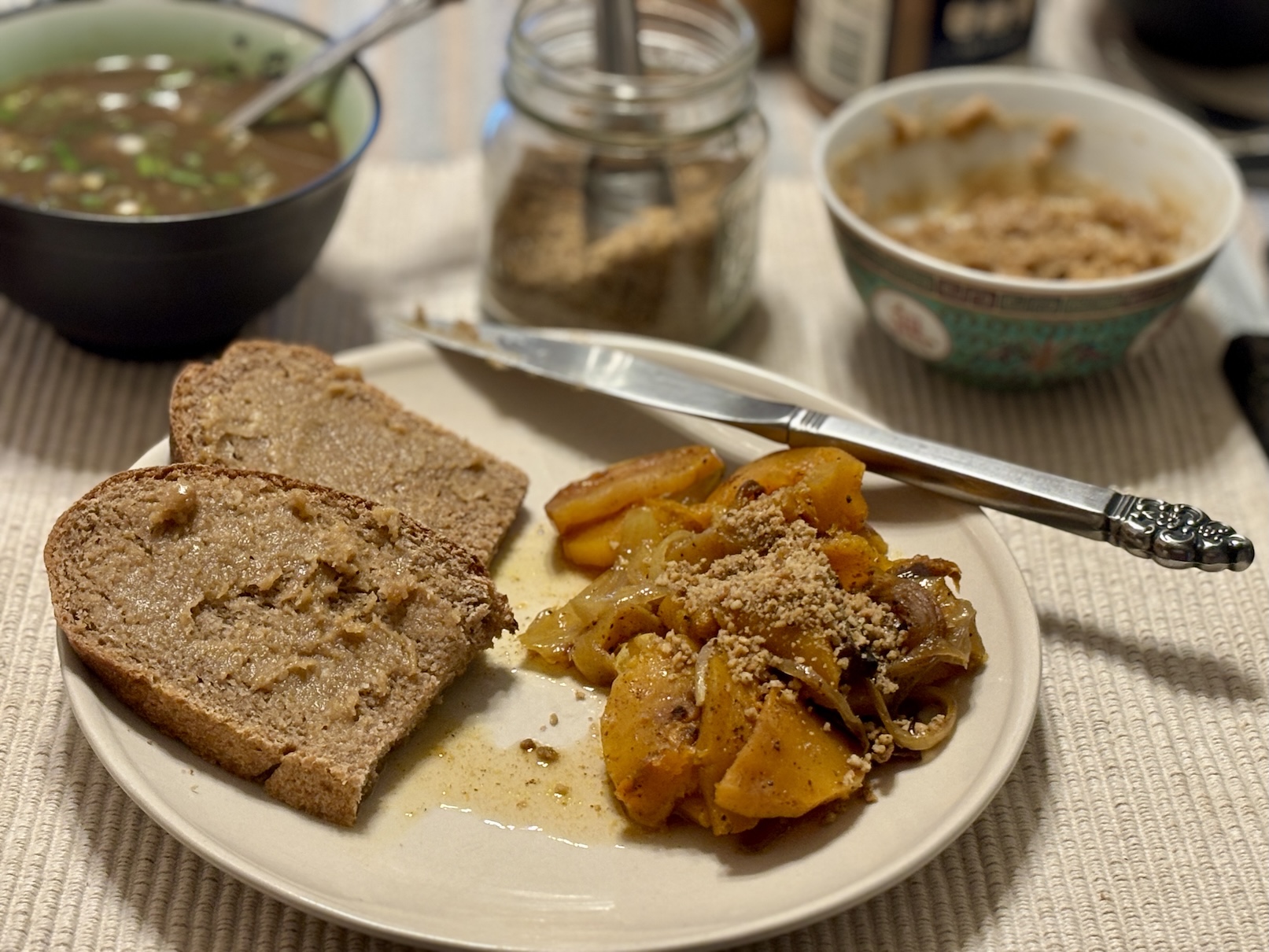 |
A note about all the resources: I've included links to those products I use, or trust to be of a better quality and value. Some of these may also be found at your local natural foods store, Whole Foods, or online for a better price at Vitacost.com. Any purchases made through the above links do provide a small commission for me, which helps support my time to continue making more informative content available, and is greatly appreciated!
Recipes Featured in This Article Using Gomashio
To Learn More...
>>>Top Recommended Healthy Condiments for Macrobiotic Cooking >>>Gomashio Sesame Salt
Want to get started eating a healthy balanced vegan macrobiotic diet / or a simple plant-based diet?



